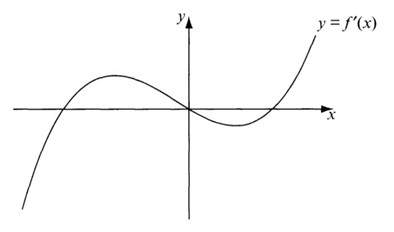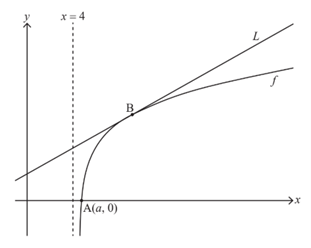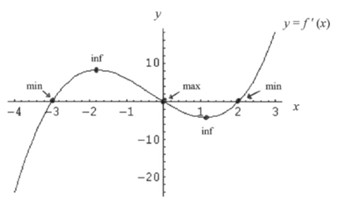Question 1
Consider the functions `f(x)=-(x-h)^2+2k` and `g(x)=e^(x-2)+k` where `h,k ∈ R`.
(a) Find `f'(x)`
The graphs of `f` and `g` have a common tangent at `x=3`.
(b) Show that `h=(e+6)/2.`.
(c) Hence, show that `k=e+e^2/4.`.
Mark as Complete
Mark Scheme
Question 2
Given `f(x)=arcsinx/lnx`, find `f^' (x)`.
Mark as Complete
Mark Scheme
Question 3
A curve in the plane has the equation `xy^2+x^2 y=2`.
(a) Find the gradient (slope) of the curve at the point `(1,1)`.
(b) Find the equation of the line which is perpendicular to the curve at the point `(1,1)`.
Mark as Complete
Mark Scheme
Question 4
The diagram shows the graph of `y=f'(x)`.

Indicate, and label clearly, on the graph
(a) the points where `y=f(x)` has minimum points;
(b) the points where `y=f(x)` has maximum points;
(c) the points where `y=f(x)` has points of inflexion.
Mark as Complete
Mark Scheme
Question 5
Find `f'(x)` where `f(x)=xlnx+e^(sinx) +arctanx`
Mark as Complete
Mark Scheme
Question 6
The function `f` is defined for all `x∈R`. The line with equation `y=6x-1` is the tangent to the graph of `f` at `x=4`.
(a) Write down the value of `f'(4)`.
(b) Find `f(4)`
The function `g` is defined for all `x∈R` where `g(x)=x^2-3x` and `h(x)=f(g(x))`.
(c) Find `f(4)`
(d) Hence find the equation of the tangent to the graph of `h` at `x=4`.
Mark as Complete
Mark Scheme
Question 7
Let `y=lnx/x^4` for `x>0`.
(a) Show that `dy/( dx)=(1-4lnx)/x^5 .`
Consider the function defined by `f(x)=lnx/x^4` for `x>0` and its graph `y=f(x)`.
(b) The graph of `f` has a horizontal tangent at point `P`. Find the coordinates of `P`.
(c) Given that `f^('')(x)=(20lnx-9)/x^6`, show that `P` is a local maximum point.
(d) Solve `f(x)>0` for `x>0`.
(e) Sketch the graph of `f`, showing clearly the value of the `x`-intercept and the approximate position of point `P`.
Mark as Complete
Mark Scheme
Question 8
Consider the function `f` defined by `f(x)=ln(x^2-16)` for `x>4`.
The following diagram shows part of the graph of `f` which crosses the `x`-axis at point A , with coordinates `(a,0)`. The line `L` is the tangent to the graph of `f` at the point B .

(a) Find the exact value of `a`
(b) Given that the gradient of `L` is `1/3`, find the `x`-coordinate of `B`.
Mark as Complete
Mark Scheme
Question 9
Consider a function `f` with domain `a < x < b`. The following diagram shows the graph of `f'`, the derivative of `f`.

The graph of `f'`, the derivative of `f`, has `x`-intercepts at `x=p,x=0` and `x=t`. There are local maximum points at `x=q` and `x=t` and a local minimum point at `x=r`.
(a) Find all the values of `x` where the graph of `f` is increasing. Justify your answer.
(b) Find the value of `x` where the graph of `f` has a local maximum.
(c)
(i) Find the value of `x` where the graph of `f` has a local minimum. Justify your answer.
(ii) Find the values of `x` where the graph of `f` has points of inflexion. Justify your answer.
(d) The total area of the region enclosed by the graph of `f'`, the derivative of `f`, and the `x`-axis is 20 .
Given that `f(p)+f(t)=4`, find the value of `f(0)`.
Mark as Complete
Mark Scheme
Question 10
Consider the curve with equation `y=(2x-1)e^(kx)`, where `x∈R` and `k∈Q`. The tangent to the curve at the point where `x=1` is parallel to the line `y=5e^k x`. Find the value of `k`.
Mark as Complete
Mark Scheme
Question 1
Consider the functions `f(x)=-(x-h)^2+2k` and `g(x)=e^(x-2)+k` where `h,k ∈ R`.
(a) Find `f'(x)`
The graphs of `f` and `g` have a common tangent at `x=3`.
(b) Show that `h=(e+6)/2.`.
(c) Hence, show that `k=e+e^2/4.`.
(a) `f^' (x)=-2(x-h)`
(b) `g^' (x)=e^(x-2)` OR `g^' (3)=e^(3-2)` (may be seen anywhere)
recognizing `f^' (3)=g^' (3)`
`-2(3-h)=e^(3-2) (=e)`
`-6+2h=e" OR " 3-h=-e/2`
`h=(e+6)/2`
(c) `f(3)=g(3)`
`-(3-h)^2+2k=e^(3-2)+k`
correct equation in `k`
`-(3-(e+6)/2)^2+2k=e^(3-2)+k`
`k=e+((6-e-6)/2)^2 (=e+((-e)/2)^2 )`
Answer: `k=e+e^2/4`
Question 2
Given `f(x)=arcsinx/lnx`, find `f^' (x)`.
`f^' (x)=(lnx/sqrt(1-x^2 )-arcsinx/x)/((lnx)^2 )`
`=(xlnx-sqrt(1-x^2 ) arcsinx)/(xsqrt(1-x^2 )(lnx)^2 )`
Answer: `f^' (x)=(xlnx-sqrt(1-x^2 ) arcsinx)/(xsqrt(1-x^2 )(lnx)^2 )` or any equivalent form. (Simplification of the final answer is not required.)
Question 3
A curve in the plane has the equation `xy^2+x^2 y=2`.
(a) Find the gradient (slope) of the curve at the point `(1,1)`.
(b) Find the equation of the line which is perpendicular to the curve at the point `(1,1)`.
Differentiate `xy^2+x^2 y=2`, implicitly with respect to `x`.
Hence `y^2+2xyy^'+2xy+x^2 y^'=0`
or: `y^'=-(2xy+y^2 )/(2xy+x^2 )`
(a) Thus, the gradient of the curve at `(1,1)` is -1 .
(b) Slope of the line perpendicular to the centre at `(1,1)` is 1
Equation of the line perpendicular to the curve at `(1,1)` is `y-1=1(x-1)` or `y=x`
Answers: (a) Gradient `=-1` (b) Equation of the line is `y=x`
Question 4
The diagram shows the graph of `y=f'(x)`.

Indicate, and label clearly, on the graph
(a) the points where `y=f(x)` has minimum points;
(b) the points where `y=f(x)` has maximum points;
(c) the points where `y=f(x)` has points of inflexion.

(a) Minimum points
(b) Maximum point
(c) Points of inflexion
Question 5
Find `f'(x)` where `f(x)=xlnx+e^(sinx) +arctanx`
`f'(x)=lnx+x/x+e^(sinx)cosx+1/(1+x^2 )`
`=lnx+1+e^(sinx)cosx+1/(1+x^2 )`
Answer:
`f^' (x)=1+lnx+e^(sinx)cosx+1/(1+x^2 )`
Question 6
The function `f` is defined for all `x∈R`. The line with equation `y=6x-1` is the tangent to the graph of `f` at `x=4`.
(a) Write down the value of `f'(4)`.
(b) Find `f(4)`
The function `g` is defined for all `x∈R` where `g(x)=x^2-3x` and `h(x)=f(g(x))`.
(c) Find `f(4)`
(d) Hence find the equation of the tangent to the graph of `h` at `x=4`.
(a) `f^' (4)=6`
(b) `f(4)=6×4-1=23`
(c)
`h(4)=f(g(4))`
`h(4)=f(4^2-3×4)=f(4)`
`h(4)=23`
(d) attempt to use chain rule to find `h'`
`f^' (g(x))×g^' (x)" OR " (x^2-3x)^'×f^' (x^2-3x)`
`h^' (4)=(2×4-3)f^' (4^2-3×4)`
`=30`
`y-23=30(x-4)" OR " y=30x-97`
Question 7
Let `y=lnx/x^4` for `x>0`.
(a) Show that `dy/( dx)=(1-4lnx)/x^5 .`
Consider the function defined by `f(x)=lnx/x^4` for `x>0` and its graph `y=f(x)`.
(b) The graph of `f` has a horizontal tangent at point `P`. Find the coordinates of `P`.
(c) Given that `f^('')(x)=(20lnx-9)/x^6`, show that `P` is a local maximum point.
(d) Solve `f(x)>0` for `x>0`.
(e) Sketch the graph of `f`, showing clearly the value of the `x`-intercept and the approximate position of point `P`.
(a) attempt to use quotient or product rule
`dy/( dx)=(x^4 (1/x)-(lnx)(4x^3 ))/(x^4 )^2 " OR "(lnx)(-4x^(-5) )+(x^(-4) )(1/x)`
correct working
`=(x^3 (1-4lnx))/x^8 " OR cancelling " x^3 " OR " (-4lnx)/x^5 +1/x^5`
`=(1-4lnx)/x^5`
(b) `f^' (x)=dy/( dx)=0`
`(1-4lnx)/x^5 =0`
`lnx=1/4`
`x=e^(1/4)`
substitution of their `x` to find `y`
`y=(lne^(1/4))/(e^(1/4) )^4`
`=1/(4e) (=1/4 e^(-1) )`
`P(e^(1/4),1/4e)`
(c) `f^('')(e^(1/4) )=(20lne^(1/4)-9)/(e^(1/4) )^6`
`=(5-9)/e^1.5 (=-4/e^1.5 )`
which is negative
hence P is a local maximum
(d) `lnx>0`
`x>1`
(e)

Question 8
Consider the function `f` defined by `f(x)=ln(x^2-16)` for `x>4`.
The following diagram shows part of the graph of `f` which crosses the `x`-axis at point A , with coordinates `(a,0)`. The line `L` is the tangent to the graph of `f` at the point B .

(a) Find the exact value of `a`
(b) Given that the gradient of `L` is `1/3`, find the `x`-coordinate of `B`.
(a) `ln(x^2-16)=0`
`e^0=x^2-16(=1)`
`x^2=17` OR `x=±sqrt17`
`a=sqrt17`
(b) attempt to differentiate (must include `2x` and/or `1/(x^2-16)` )
`f^' (x)=(2x)/(x^2-16)`
setting their derivative `=1/3`
`(2x)/(x^2-16)=1/3`
`x^2-16=6x` OR `x^2-6x-16=0` (or equivalent)
valid attempt to solve their quadratic
`x=8`
Question 9
Consider a function `f` with domain `a < x < b`. The following diagram shows the graph of `f'`, the derivative of `f`.

The graph of `f'`, the derivative of `f`, has `x`-intercepts at `x=p,x=0` and `x=t`. There are local maximum points at `x=q` and `x=t` and a local minimum point at `x=r`.
(a) Find all the values of `x` where the graph of `f` is increasing. Justify your answer.
(b) Find the value of `x` where the graph of `f` has a local maximum.
(c)
(i) Find the value of `x` where the graph of `f` has a local minimum. Justify your answer.
(ii) Find the values of `x` where the graph of `f` has points of inflexion. Justify your answer.
(d) The total area of the region enclosed by the graph of `f'`, the derivative of `f`, and the `x`-axis is 20 .
Given that `f(p)+f(t)=4`, find the value of `f(0)`.
(a) `f` increases when `p < x < 0`
`f` increases when `f^' (x)>0` OR `f'(x)` is above the `x`-axis
(b) `x=0`
(c)
(i) `f` is minimum when `x=p`
because `f^' (p)=0,f^' (x)<0` when `x and `f^' (x)>0` when `x>p` (may be seen in a sign diagram clearly labelled as `f'` )
OR because `f'` changes from negative to positive at `x=p`
OR `f^' (p)=0` and slope of `f'` is positive at `x=p`
(ii) has points of inflexion when `x=q,x=r` and `x=t`
`f'` has turning points at `x=q,x=r` and `x=t`
OR `f^('')(q)=0,f^('')(r)=0` and `f^('')(t)=0` and `f'` changes from increasing to decreasing or vice versa at each of these `x`-values (may be seen in a sign diagram clearly labelled as `f^('')` and `f'` )
(d) recognizing area from `p` to `t` (seen anywhere)
`∫_p^t|f^' (x)| dx`
recognizing to negate integral for area below `x`-axis
`∫_p^0f^' (x)dx-∫_0^tf^' (x)dx` OR `∫_p^0f^' (x)dx+∫_t^0f^' (x)dx`
`∫_m^nf^' (x)dx=f(n)-f(m)` (for any integral)
`f(0)-f(p)-[f(t)-f(0)]` OR `f(0)-f(p)+f(0)-f(t)`
`2f(0)-[f(t)+f(p)]=20,2f(0)-4=20`
`f(0)=12`
Question 10
Consider the curve with equation `y=(2x-1)e^(kx)`, where `x∈R` and `k∈Q`. The tangent to the curve at the point where `x=1` is parallel to the line `y=5e^k x`. Find the value of `k`.
evidence of using product rule
`dy/( dx)=(2x-1)×(ke^(kx))+2×e^(kx)(=e^(kx)(2kx-k+2))`
correct working for one of (seen anywhere)
`dy/( dx)` at `x=1⇒ke^k+2e^k`
OR
slope of tangent is `5e^k`
their `dy/( dx)` at `x=1` equals the slope of `y=5e^k x(=5e^k )` (seen anywhere)
`ke^k+2e^k=5e^k`
`k=3`
Question 1
Consider the functions `f(x)=-(x-h)^2+2k` and `g(x)=e^(x-2)+k` where `h,k ∈ R`.
(a) Find `f'(x)`
The graphs of `f` and `g` have a common tangent at `x=3`.
(b) Show that `h=(e+6)/2.`.
(c) Hence, show that `k=e+e^2/4.`.
Question 2
Given `f(x)=arcsinx/lnx`, find `f^' (x)`.
Question 3
A curve in the plane has the equation `xy^2+x^2 y=2`.
(a) Find the gradient (slope) of the curve at the point `(1,1)`.
(b) Find the equation of the line which is perpendicular to the curve at the point `(1,1)`.
Question 4
The diagram shows the graph of `y=f'(x)`.

Indicate, and label clearly, on the graph
(a) the points where `y=f(x)` has minimum points;
(b) the points where `y=f(x)` has maximum points;
(c) the points where `y=f(x)` has points of inflexion.
Question 5
Find `f'(x)` where `f(x)=xlnx+e^(sinx) +arctanx`
Question 6
The function `f` is defined for all `x∈R`. The line with equation `y=6x-1` is the tangent to the graph of `f` at `x=4`.
(a) Write down the value of `f'(4)`.
(b) Find `f(4)`
The function `g` is defined for all `x∈R` where `g(x)=x^2-3x` and `h(x)=f(g(x))`.
(c) Find `f(4)`
(d) Hence find the equation of the tangent to the graph of `h` at `x=4`.
Question 7
Let `y=lnx/x^4` for `x>0`.
(a) Show that `dy/( dx)=(1-4lnx)/x^5 .`
Consider the function defined by `f(x)=lnx/x^4` for `x>0` and its graph `y=f(x)`.
(b) The graph of `f` has a horizontal tangent at point `P`. Find the coordinates of `P`.
(c) Given that `f^('')(x)=(20lnx-9)/x^6`, show that `P` is a local maximum point.
(d) Solve `f(x)>0` for `x>0`.
(e) Sketch the graph of `f`, showing clearly the value of the `x`-intercept and the approximate position of point `P`.
Question 8
Consider the function `f` defined by `f(x)=ln(x^2-16)` for `x>4`.
The following diagram shows part of the graph of `f` which crosses the `x`-axis at point A , with coordinates `(a,0)`. The line `L` is the tangent to the graph of `f` at the point B .

(a) Find the exact value of `a`
(b) Given that the gradient of `L` is `1/3`, find the `x`-coordinate of `B`.
Question 9
Consider a function `f` with domain `a < x < b`. The following diagram shows the graph of `f'`, the derivative of `f`.

The graph of `f'`, the derivative of `f`, has `x`-intercepts at `x=p,x=0` and `x=t`. There are local maximum points at `x=q` and `x=t` and a local minimum point at `x=r`.
(a) Find all the values of `x` where the graph of `f` is increasing. Justify your answer.
(b) Find the value of `x` where the graph of `f` has a local maximum.
(c)
(i) Find the value of `x` where the graph of `f` has a local minimum. Justify your answer.
(ii) Find the values of `x` where the graph of `f` has points of inflexion. Justify your answer.
(d) The total area of the region enclosed by the graph of `f'`, the derivative of `f`, and the `x`-axis is 20 .
Given that `f(p)+f(t)=4`, find the value of `f(0)`.
Question 10
Consider the curve with equation `y=(2x-1)e^(kx)`, where `x∈R` and `k∈Q`. The tangent to the curve at the point where `x=1` is parallel to the line `y=5e^k x`. Find the value of `k`.